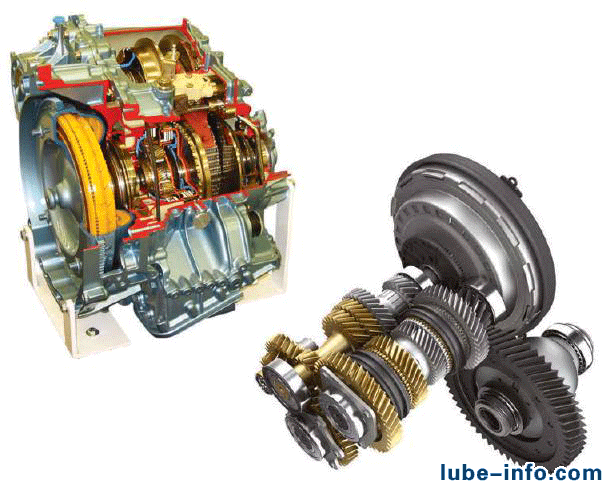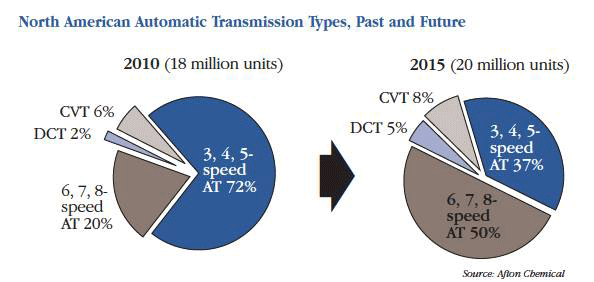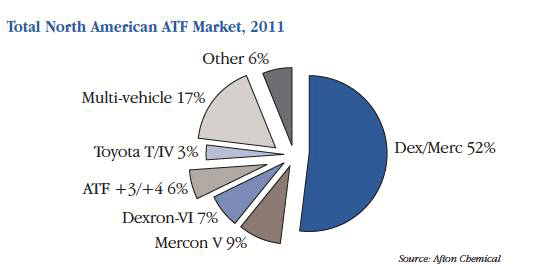Myths of the Multivehicle ATF
2013-04-08 来源:润滑油情报网

There was a time when the vast majority of automatic transmission needs were satisfied with a single transmission fluid, Dex/Merc. That’s not true anymore. Today, many original equipment manufacturers require unique, stand-alone fluids that meet their specific requirements.
Fluid specifications vary for each transmission type, and additives must be carefully formulated to deliver the right balance of friction, wear resistance, oxidation resistance, extreme-pressure properties, aeration control and durability. As transmission hardware becomes more complex and compact, developing the fluid and hardware in parallel is the only way to provide optimum performance and component protection, as well as other benefits such as fuel efficiency and extended drain intervals.
Why Multi-vehicle Fluid Is Waning
Multi-vehicle ATF was introduced so that an installer or quick-lube did not have to carry so many different fluids. Generally, formulators would design one or two fluids to serve the majority of vehicles likely to come in for service.
This was fine until Ford and General Motors deactivated their respective Mercon and Dexron-III specifications about six years ago. Ford replaced the former with Mercon V, GM created Dexron-VI, and both declared that the expired products were obsolete and no longer to be used. Since then, auto manufacturers have evolved or substantially changed their transmission designs so this older fluid technology now only meets the needs of a decreasing number of vehicles.
Afton Chemical has been doing market research on ATFs for the past five years. While unlicensed Dex/Merc fluid still comprises a significant portion of the market, we see that portion declining considerably in the next five years. Conversely, market share has increased for current specifications such as Mercon V and Dexron-VI.
Penetration of these newer fluids is greater at car dealerships, where Mercon V has 25 percent market share and Dexron-VI 21 has percent. Multi-vehicle (universal) fluids remain the secondlargest application, particularly at quick lubes (39 percent) and repair garages (23 percent).
This situation has given rise to a great deal of confusion in the industry with respect to which ATF should be recommended for which transmission type. The confusion has led to some myths that, at best, cause the consumer to pay more for transmission fluid changes and, at worst, damage transmissions that the fluid is meant to protect.
Five Fluid Myths Myth 1: Top-treats can be added to an older Dex/Merc fluid to convert its performance to a later specification such as Mercon V or Dexron-VI. Further, top-treated ATFs deliver the same performance as OEMspecific formulations.
The Reality: This is a bit like suggesting a Formula 1 champion driving an ordinary car could compete head-tohead with a Formula 1 car on the racetrack. In fact, meeting the stringent formulation parameters set by automakers requires specific base oil and additive combinations.
Because base oil comprises 80 to 90 percent of a typical ATF, it is not possible to dramatically alter the viscometric properties of the fluid with a small bottle of additive. This is especially true if the top treatment is added to a fluid formulated with poor-quality API Group I base oils. The reason for this is that Group I oils have inherently worse coldtemperature performance in addition to lower thermal and oxidative stability.
Using an older specification fluid plus a top-treat to convert it to a new specification can be seriously detrimental to fluid performance, and is not recommended by automakers. Performance that may be compromised by using top-treated fluid includes shifting, oxidative stability, fuel efficiency and transmission life.
There is also a risk of increased wear, caused by an improperly balanced additive system. If the basic performance is not present from the start, top treating won’t miraculously get you there.
It also has been suggested that prod- ucts are available that allow the installer market (quick lubes and garages) to stock one or two basic ATFs, then simply top-treat with a dose of bottled additives that supposedly meet a variety of vehicle specifications. However,
We have sampled numerous products from the marketplace, and found that ATF performance deteriorates in many areas following addition of a top-treat. In one case, the friction performance of a top-treated fluid deteriorated to such a degree that torque capacity was substantially reduced. This would likely lead to clutch plate slipping that the driver would feel as poor shifts, accompanied by excessive heat and glazing.
Myth 2: Merely meeting the viscosity requirements of a specification makes a fluid suitable for transmissions covered by it.
The Reality: Viscosity is only part of the story. ATFs serve a variety of functions in a transmission and are formulated with additives designed to meet the needs of specific transmission types. Additives include antiwear, rust and corrosion inhibitors, detergents, dispersants and surfactants (that protect and clean metal surfaces), viscosity modifiers, anti-shudder additives, seal swell additives, agents that extend temperature range, antifoam agents and antioxidants to inhibit oxidation and improve fluid stability.
Myth 3: It is possible to meet multiple specifications and approvals when the viscometric requirements of those approvals are mutually exclusive.
The Reality: The fallacy of this statement is self-evident. For example, the maximum viscosity for Dexron-VI fluid when new is 6.4 centiStokes at 100 degrees C, while the minimum new-fluid viscosity for Mercon V is 6.8 cSt and often greater than 7.0 cSt. There is no way a single fluid can meet both specifications.
Finally, viscosity requirements for continuously variable transmissions (CVTs), dual-clutch transmissions (DCTs) and heavy-duty transmissions vary significantly from these values. CVT fluids must handle steel-on-steel friction and protect both belt- and pulley-type CVTs. Fluids designed for conventional transmissions can cause a CVT to fail due to belt slippage. DCT fluids must handle higher extreme pressures, accommodate the special frictional needs of the synchronizers, and have different frictional properties to work with a friction-launch clutch rather than a torque converter.
Myth 4: ATF labeling laws relate only to packaged products, not to bulk oils.
The Reality: A consultation with the California Department of Weights and Measures confirmed that bulk shipments are covered by that state’s labeling law. Even with bulk shipments, the marketer should ensure that either the container or the accompanying documents satisfy
Myth 5: Defining a “suitable for use” list, showing vehicle models rather than ATF specifications met, is always satisfactory.
The Reality: Here too, the California Department of Weights and Measures informed us that they enforce duty-type specifications, measured by industry established procedures. The agency figures that if the statute says you must meet recommended specifications, it means you must follow Dexron, Mercon and other specification requirements. They even will cite and pull from sale an ATF that fails to comply.
Basic Specs While there are more than 70 ATF specifications and claims, in the North American market the specifications issued by General Motors, Ford, Chrysler and JASO-1A are most significant. Fluids meeting the requirements of these specifications each differ in some key ways from the others, relating to viscosity, oxidation, friction durability, aeration control and wear protection. Optimum performance requires a careful balance of these important attributes.
The basic performance goals of each OEM in issuing these specifications are durability, shift feel, fuel efficiency and compatibility with the materials inside the transmission. This last requirement is becoming increasingly important because there are about 1,000 different components in an automatic transmission. In addition, new transmissions operate at higher temperatures, with smaller sumps and longer drain intervals. And OEMs are introducing new materials to simultaneously reduce cost and increase durability.
Since the ATF touches every component in the transmission, material compatibility is critical. Licensed fluids offer the assurance that a fluid formulation has been evaluated and approved by the OEM for acceptable material compatibility.
The ATF market is becoming more fragmented, and the opportunity to market ATF with multiple specifications is diminishing. The latest count of the
By 2015, the largest vehicle population in
As a result, the best strategy for formulators to meet the needs of the market is to offer five or six fluids. Three would be aimed at conventional automatic transmissions — namely, a Mercon V, a Chrysler ATF+4, and a low-viscosity fluid that satisfies Dexron-VI/Mercon LV/JASO 1A. In addition, the market needs separate fluids for CVTs and DCTs. Finally, heavy-duty transmissions would be served by Allison-approved fluids such as those meeting TES 295.
The bottom line is that blenders cannot streamline part of their formulations or take shortcuts, because the legal and technical risks associated with shortcuts have increased substantially in the past five years. This has happened with the explosion of new transmission designs that are often linked to the automakers’ Corporate Average Fuel Economy claims, which are legally binding.
To emphasize the importance of using proper fluids, General Motors’ website states in part that “Dexron ATF contains the prescribed combination of additives that improve lubricating qualities for your GM vehicle. ...Due to the complexity of these fluids, it is very important that both technicians and owners refer to their Owner’s Manuals in order to ensure they’re selecting the correct fluid for the given application.”
Further, the Chrysler owner’s manual states: “Automatic Transmission Fluid (ATF) is an engineered product and its performance may be impaired by supplemental additives. Therefore, do not add any fluid additives to the transmission. The only exception to this policy is the use of special dyes to aid in detecting fluid leaks. In addition, avoid using transmission sealers as they may adversely affect seals.”
The conclusion: The best way to mitigate risk is to choose products that are OEM licensable. When in doubt, ask the additive supplier for the data to support its claims.









 粤公网安备 44010402003386号
粤公网安备 44010402003386号